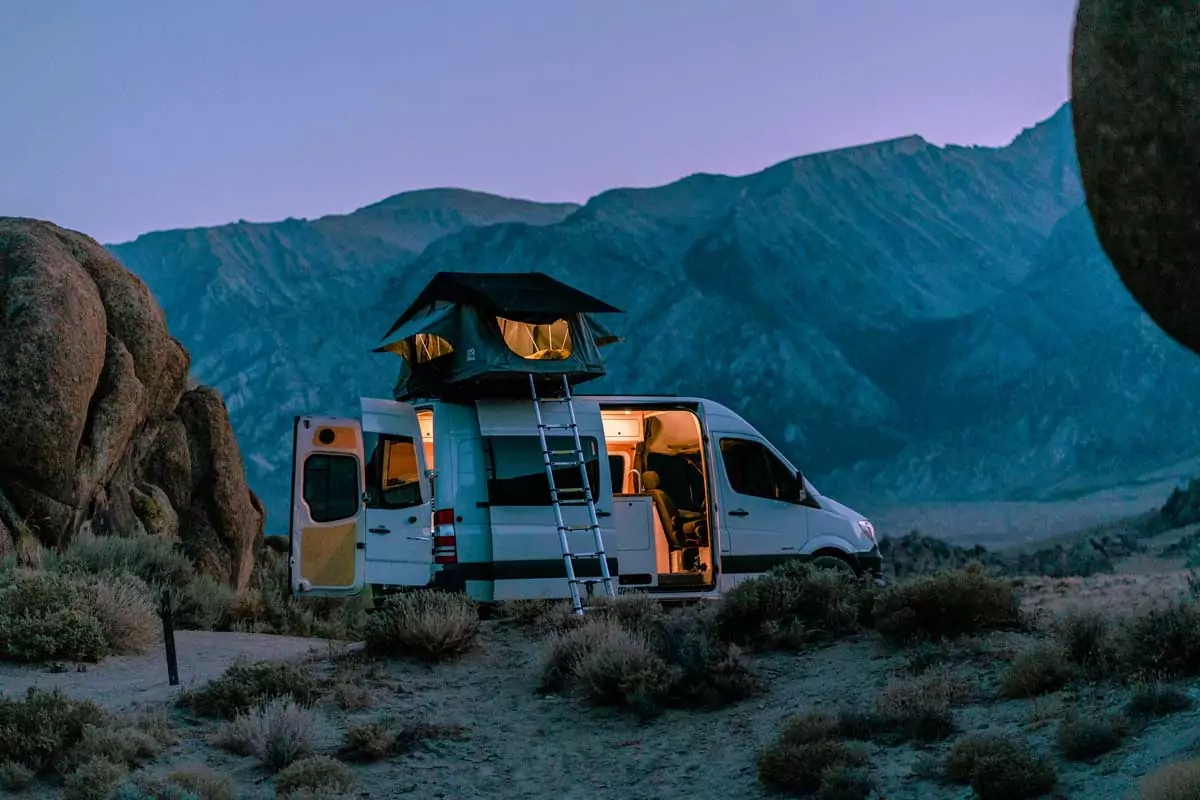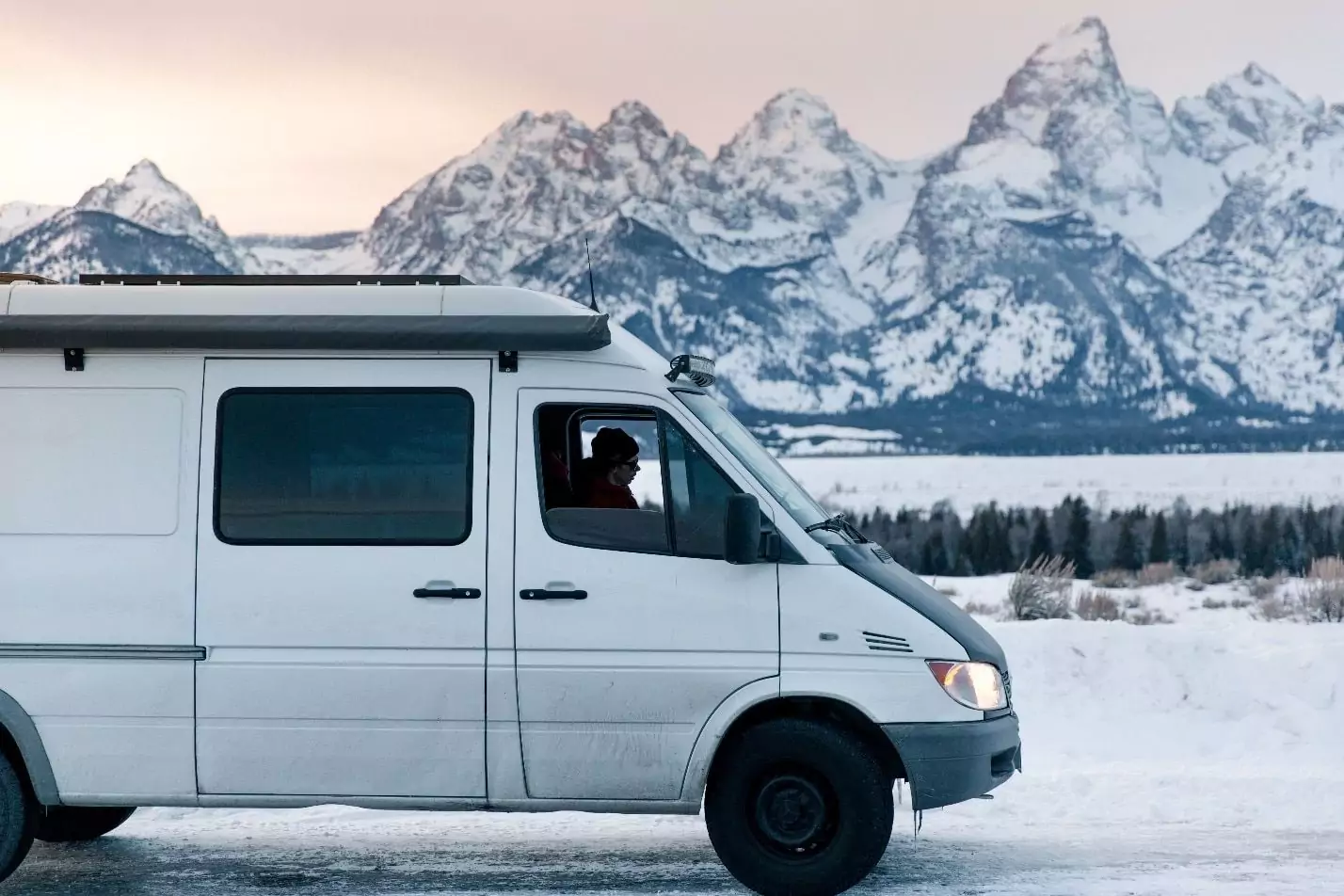If you’ve found yourself reading this blog we are going to assume you’re at least somewhat interested in taking a winter road trip. We want to congratulate you for wanting to join a very select and privileged group of like-minded travelers who are inspired by winter adventure. Many people are put off by the idea of driving in the snow or camping in the cold, but the truth is: VANLIFE IS BETTER IN THE WINTER!!!!.
Vanlife is better in the winter for a variety of reasons, which we will explain in this blog as well as tell you everything you need to know before setting off on a winter campervan road trip.
We’re splitting this how to guide into 6 separate parts: WHY ROAD TRIP IN WINTER?, SKIING/SNOWBOARDING, DRIVING IN SNOW & ICE, FINDING CAMPING, WHERE TO SHOWER, and WINTER VANLIFE TIPS & TRICKS
WHY ROAD TRIP IN WINTER?
Well…..because it’s awesome, that’s why. It’s much easier to keep a campervan warm in the winter than it is to stay cool in the summer. National Parks are empty and don’t require any special reservations to enter. You can drive into Yosemite and snag a campsite in the valley (which is unheard of in the summer time, when camping reservations sell out 6 months in advance).
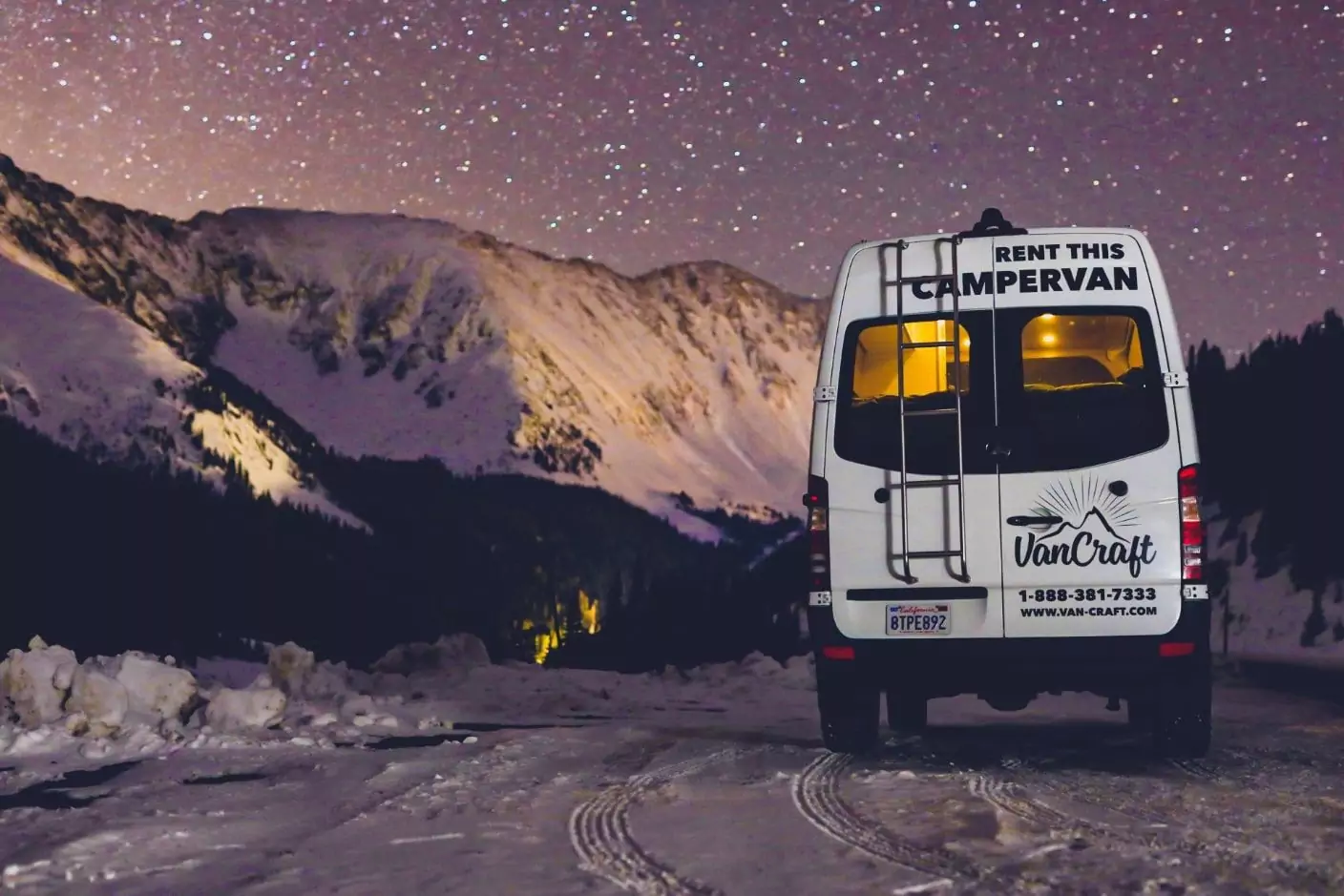
Winter vanlife has something to offer everyone, whether you’re a skier or snowboarder looking to maximize your days this season, or just looking to relax by visiting some of the best hot springs in the western US. A campervan road trip is quite literally the perfect vehicle to make your winter one to remember. Don’t take our word for it, give winter vanlife a try and see for yourself! After all, snowcapped mountains and frozen landscapes are best enjoyed in person.
Traveling in extreme elements while staying comfortable and warm evokes a very similar feeling to relaxing by the fire place in a cozy cabin.
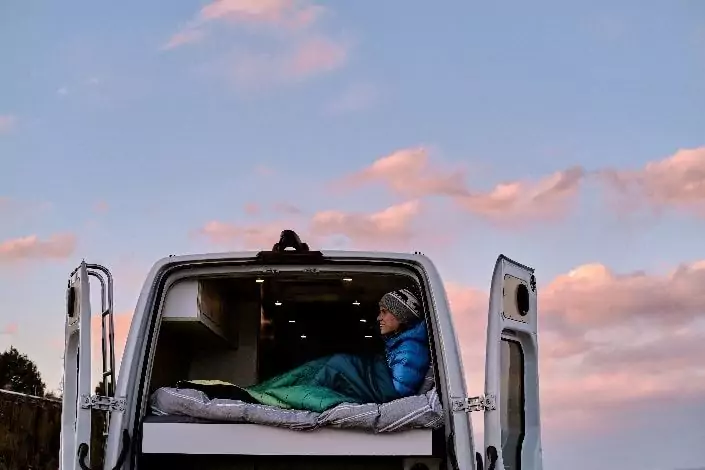
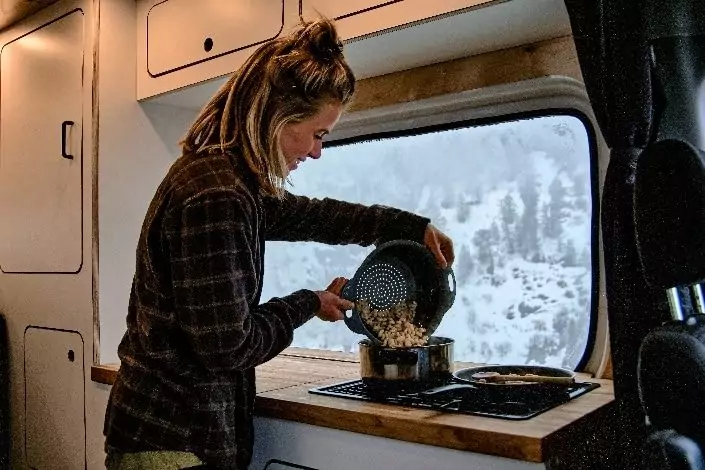
Most importantly: VanCraft campervans are specially designed to be suited for all 4 seasons, especially winter.
All VanCraft Campervans include the following winter features:
- Airtronic cabin heater to keep the interior warm & dry 24/7
- All season tires with included snow cables (not chains, which are difficult to use)
- Internal water tanks, and one simple switch to winterize and avoid freezing
- FREE winter kit that includes an ice scraper, back up propane heater, and extra warm sleeping bags
SKIING & SNOWBOARDING:
One of the biggest benefits of taking a winter campervan road trip is the opportunity for skiing and snowboarding. Renting a campervan for your next trip can be a very cost effective when compared to AIRBNBs or resort lodging. It also offers the flexibility of being able to visit multiple ski resorts in one trip.
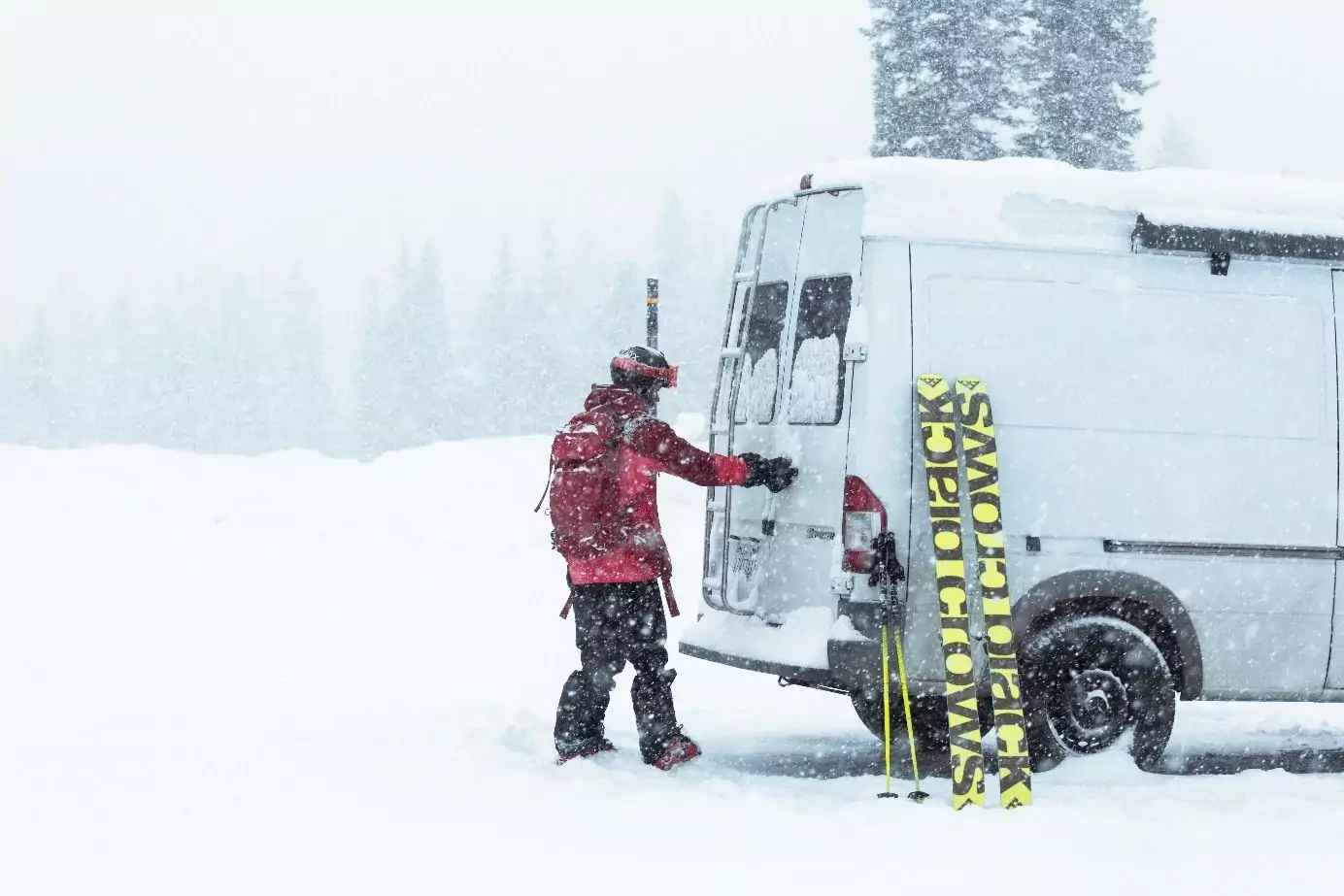
Buy a ski pass: IKON, EPIC, or Mountain Collective are three of our favorites.
Our recommendation is to purchase one of the popular multi resort ski passes: IKON, EPIC, or Mountain Collective. Each pass gives you access to multiple ski resorts across the western US. If you’re only going to be able to take one trip this ski season, the Mountain Collective Pass may be your best option. Mountain Collective gives you two days at 24 different ski resorts and costs $429. With ticket window prices at popular resorts over $150-$200/day you can see how the Mountain Collective pass will quickly pay for itself. A bonus with this pass is that you also receive 50% off tickets if you want to ski at any one resort for more than the 2 free days.
The other two passes that are even more robust are the IKON and EPIC. The IKON pass runs $799 for a base and $999 for a regular pass. The only difference between base and regular are blackout dates, so if you’re planning on skiing over any holidays, make sure to buy the upgraded pass. IKON gives you a season pass at a handful of resorts, and 5-7 days at all of the other resorts on the pass. EPIC is very similar in that it also offers a season pass at multiple resorts and 5 days of access at a handful of other resorts. In general, EPIC is best for Colorado ski trips, and IKON or Mountain Collective are better bets for some of the more famous ski resorts across the Western US.
Here is a quick breakdown to highlight what resorts are included on each pass:
IKON: Mammoth Mountain, Big Bear, Squaw Valley in Lake Tahoe, Aspen/Snowmass, Copper Mountain, Arapahoe Basin In Colorado, Alta & Snowbird in Utah, Jackson Hole Wyoming, Big Sky Montana, Banff SkiBig3, Revelstoke in Canada, Cypress Mountain, Crystal Mountain Washington, and Mt. Bachelor in Bend, Oregon.
EPIC: Heavenly & Kirkwood in Lake Tahoe CA, Vail, Breckenridge, Keystone, Crested Butte, Telluride in Colorado, Park City & Snowbasin in Utah, Sun Valley Idaho, Kicking Horse, Mont-Sainte Anne, Fernie Alpine Resort, Whistler Blackcomb in Canada, and Stevens Pass Washington.
Mountain Collective: Mammoth Mountain & Palisades Tahoe in California, Aspen & Arapahoe Basin in Colorado, Alta, Snowbird in Utah, Jackson Hole & Grand Targhee in Wyoming, Big Sky Montana, Lake Loise, Banff, and Revelstoke in Canada.
We’ve created trip itineraries for each pass: check them out by CLICKING HERE: ITINERARIES
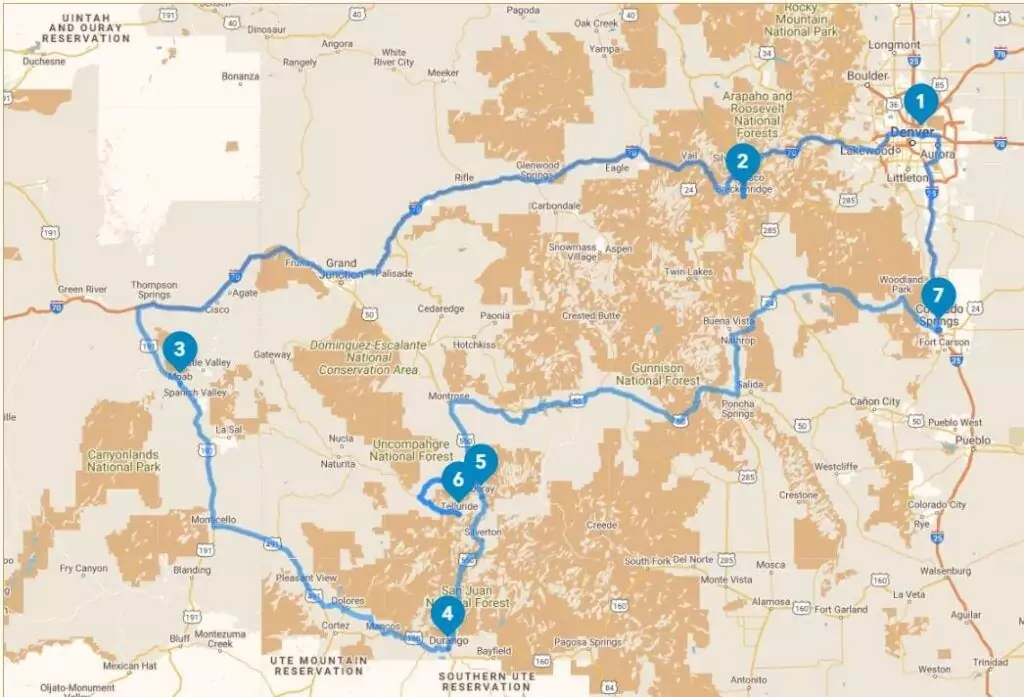
Live out your dream of being a ski bum! Rent a campervan & buy a ski pass this season! Just don’t tell your boss, or save up enough vacation days to take off the entire month from Thanksgiving through New Year’s! We promise, it’s a once in a lifetime experience that you will not regret.
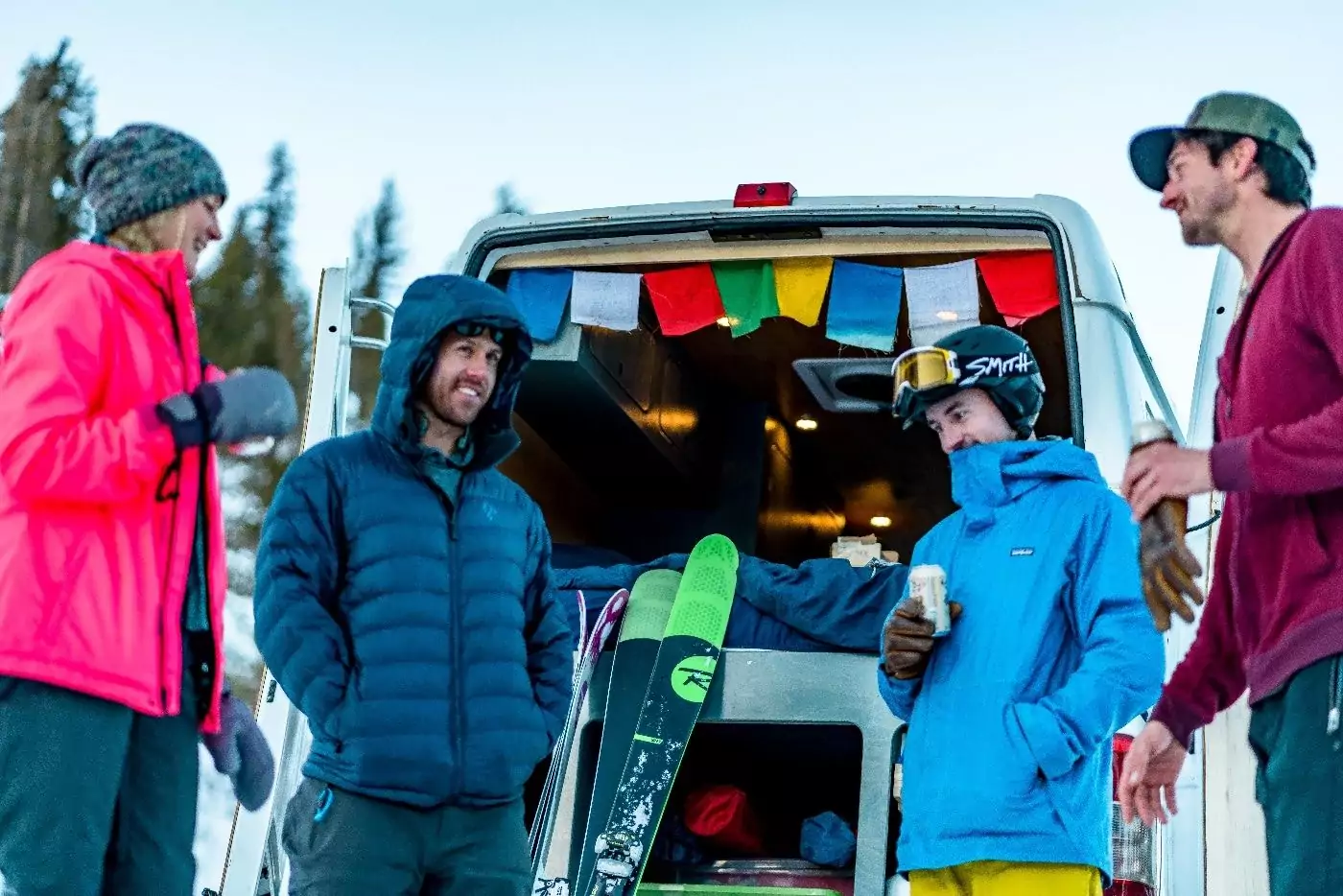
The VanCraft Guarantee: a travel experience you will not forget!
DRIVING IN SNOW & ICE:
The #1 question we get asked for winter road trips is: “Do you need 4X4?”
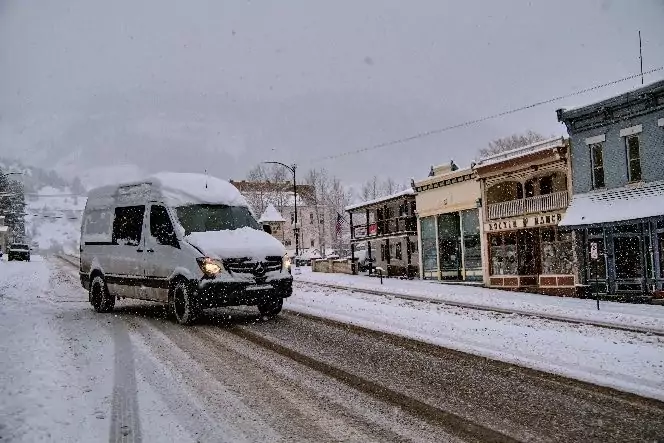
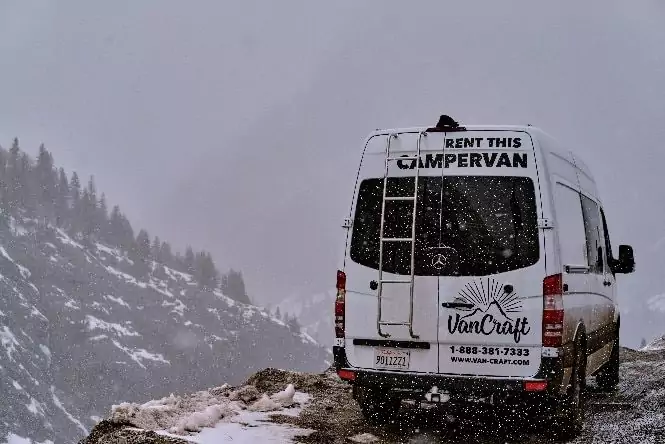
Our definitive answer is NO! One of the most important things to know about driving in the snow and ice is that even if you have 4X4, it will not help you to stop or slow down when you lose traction. All modern vehicles have anti-lock brakes on all 4 wheels. 4 wheel drive helps to not lose traction while you are accelerating, but that’s it! What is more important to avoid a crash is to not lose traction while you are braking & turning.
Our 2WD Sprinter model campervans perform surprisingly well in snow and ice. Our team has logged over 10k miles driving in all conditions during winter road trips, and we have been pleasantly surprised by the confidence the vans inspire in winter driving conditions. That being said, it is very important to drive as safely as possible in winter conditions.
Here are some tips for winter driving:
- Never exceed the speed limit and always pay attention to posted signs which may have reduced speed limits for snow and ice.
- Plan to drive during the day if there is snow or ice. Driving at night adds an additional danger because it is more difficult to see road conditions.
- Always check road conditions before making your drive. Mountain roads are often curvy and steep and roads can close.
- Leave extra distance between you and the cars you are following.
All of our rental camper vans are 2WD. Our Sprinter model campervans are RWD (rear wheel drive) and have an advanced Mercedes Benz traction control system. This traction control system works both while accelerating and braking to assist in not losing traction. Our micro campervan models are FWD (front wheel drive) and also have traction control as well as anti-lock brakes. Our FWD micro campervan model are much lighter weight.
FWD is often thought as being better for winter driving. We agree to this statement for cars, empty pickup trucks and light weight vehicles like our micro model, because most weight is in the front tires where the heavy engine is located. More weight on the tires = more traction.
In our RWD Sprinter campervan models, there is more weight over the rear tires with the water tanks, batteries, and interior conversion plus any added cargo.
Another important part of winter driving is GOOD TIRES. All of our campervans have Yokohama Geolander AT tires which carries the RMA mountain/snowflake emblem that designates it as meeting the severe weather requirements. A three-peak mountain snowflake (3PMSF) symbol branded on a tire’s sidewall indicates the tire meets required performance criteria in snow testing to be considered severe snow service-rated. We also check the tires between each rental to ensure adequate tread depth of no less than 8/32.
If you are losing traction while accelerating in any of our campervans, it is a good indication that you will need to pull over at a safe location to install the tire cables. Tire cables are similar to tire chains in that they increase the traction on ice and slick snow-covered roads; however they are much easier to install than traditional tire chains.
It is extremely important to install tire cables properly to avoid damage, and follow the strict guidelines below for driving with tire cable installed:
- Never drive over 30MPH MAX SPEED with tire cables
- Always install tire cables on the drive tires. Front wheels for micro campervans models and rear wheels for Sprinter models.
- Never turn off traction control when driving with tire cables. When the wheels start spinning and losing traction with tire cables it can break the cables and damage the vehicle.
Never drive on dry pavement with tire cables as it will break the cables and damage the vehicle. Broken cables can wrap around axles and brake components causing damages that that will end your trip.
FINDING CAMPING:
One of the benefits of traveling by campervan is that you don’t necessarily HAVE to make campsite reservations in advance and you can almost always CAMP FOR FREE. Not only can you camp for free but we encourage it and like the saying goes: some of the best things in life are free.
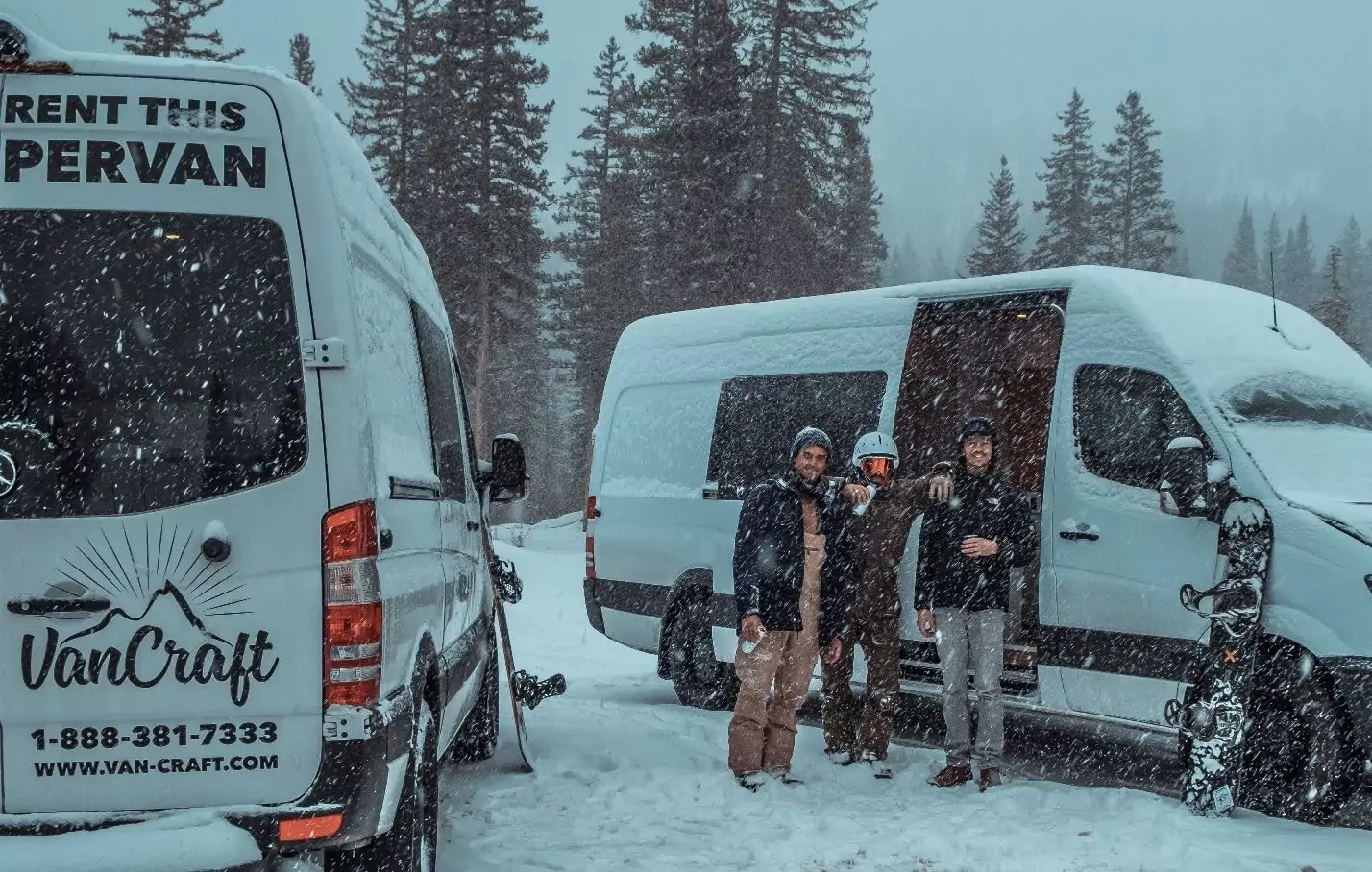
Truth be told, finding camping in the winter can be more difficult than normal, and you may have to be more flexible or creative in choosing a spot to stay for the night. This is mainly because traditional campgrounds close during the winter season. National forest service roads are not maintained in the winter and are often impassable with snow. For a detail guide on HOW TO CAMP FOR FREE check out our VANLIFE 101 blog post.
Our #1 recommendation to find FREE CAMPING in the winter is iOverlander.

iOverlander is a user submitted app that has thousands of free camping locations. The best part is that it includes user reviews of each site, and you can almost always determine if the location is suitable for winter camping just by reading the review.
While apps are a great resource for finding campsites, we also recommend you look for new places not yet on the map! You don’t NEED to stay at campsite that someone has put on a map, you can find your own free camping.
Here is a list of our favorite spots to camp/park during winter:
- Hot Springs. If you can find a hot spring that is accessible in the winter you are in luck! They often have great camping and beautiful landscapes.
- Ski resort parking lots. But be careful to read the posted signs, as most ski resorts unfortunately no longer allow overnight parking! Here is a good resource for which resorts allow you to camp overnight: https://www.curbed.com/maps/ski-resorts-overnight-parking-rv-camping
- Residential streets. Drive into town, and check the parking signs. Most residential parking limits are during daylight hours only BUT also make sure to check for snow plow restrictions.
- Trail head and public parking lots. Trail heads will often allow for overnight parking for back country access, some even have toilets and trash cans. You can also check public parking lots, sometimes you have to pay to park overnight but it can be well worth the price especially if the lot is downtown or close to bars and restaurants.
- Grocery stores, coffee shops, and small businesses. Larger cities can be tough to find parking, but Whole Foods or Starbucks are always a good bet and then you can easily get coffee and breakfast in the morning before heading up to the ski resort.
When in doubt we always advise on asking for forgiveness rather than asking for permission to park or camp, BUT that only works if you have a solid moral compass and sound set of ethics. Therefore, we require that all of our renters sign a customer code of ethics and follow the 7 Leave No Trace principles.
DISCLAIMER WARNING: Technically, there are many towns and cities where it is illegal to camp in your vehicle overnight, however more often than not you WILL NOT get a knock on your door and even if you do you will most likely not get a ticket. The same goes for ski resorts; some parking lots have posted signs not to park overnight, but you may pull in to find other RVs and campervans all camping. This is somewhat of a grey area, and victimless crime. Always be polite, ask parking lot attendants, employees, and security guards for permission if they are present.
PRO TRIP! Download the iOverlander app before you lose cell service. Also, download maps.me for offline turn by turn navigation that works with iOverlander. We repeat, download the app and all of the maps for each state you will be visiting BEFORE YOU LOSE CELL SERVICE.
WHERE TO SHOWER:
Hot springs, hot yoga, YMCA, gyms, Rec Centers aka Aquatic Centers in Canada, wet wipes or use the hot shower included with the van! Need we say more?…well sort of.
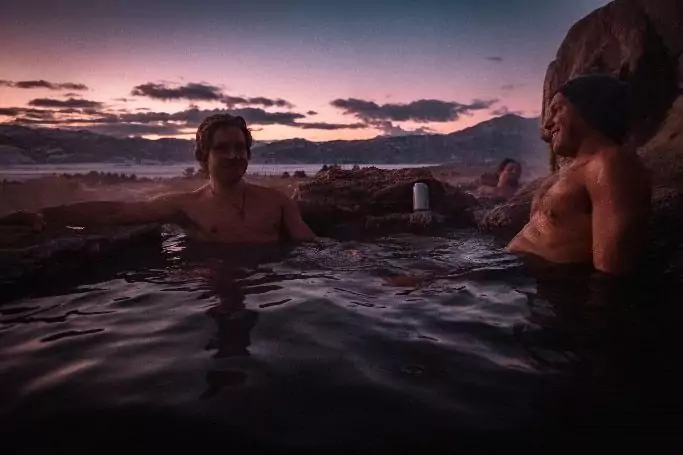
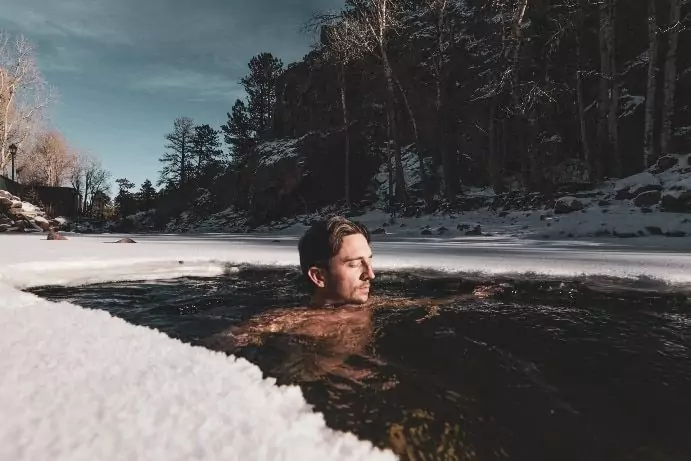
Our favorite way to relax and shower during winter road trips are hot springs. Hot springs can be both natural and resort style. Hot spring resorts always have shower facilities so you can rinse off before and after. They are pretty common place in the mountains with famous hot spring resorts that are often very close to ski resorts. i.e Glenwood Hot Springs, Strawberry Hotsprings, etc.
Natural hot springs often smell a bit funky (due to sulfur), but if you can park close enough to the springs you will still be hot when you get out and you can rinse off with the hot water shower located in the back of the campervan. Some of our favorite hot springs are located just outside Mammoth Mountain in California.
Hot yoga is also a great winter shower hack. Sign up for a yoga class, but be sure to call first to make sure they have showers. Almost all hot yoga studios do and they are plentiful in ski towns.
The YMCA generally allows for a day pass, and you can use their facilities which always includes a shower. Gyms are also great, however most will require a monthly membership. Sometime you can get a day pass or free trial but make sure to call in advance.
Mountain ski towns are also well known for having Recreation Centers, which are also called Aquatic Centers in Canada. They always have a day pass entrance fee which can range from $10-$20. They will generally have swimming pools, hot tubs, steam rooms, saunas, and of course showers!
Wet wipes can be a great way to freshen up in between showers. You don’t really need to shower every single day, do you? The essential oil wet wipes are much better than your traditional baby wipe.
Finally, another option is to just use the outside hot water shower that is included with our Sprinter campervans; however, this can be intimidating depending on the outside temp! The trick we have found that works best is to heat up the interior of the van, and have the airtonic heater running on high. Open the rear doors and fire up the shower making sure to stay in the hot water as much as possible while you suds up. Then close the rear doors and jump inside the van to dry off and warm up. Remember to winterize the shower after each use to ensure it does not freeze and burst the pipes!
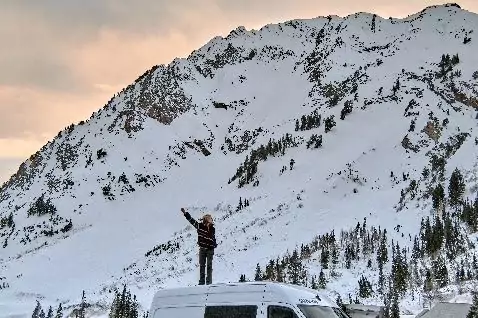
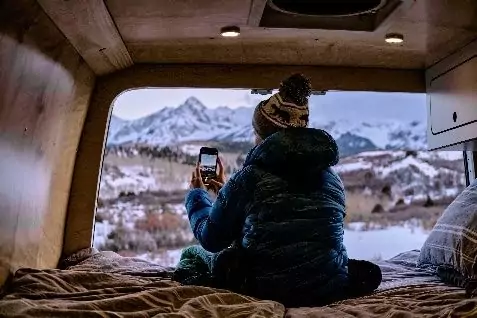
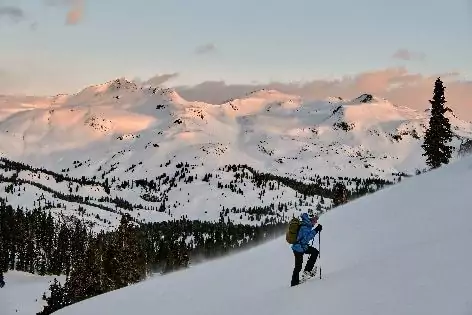
WINTER VANLIFE TIPS & TRICKS:
- Check the weather in advance and plan accordingly
- Lift up wiper blades if it will snow overnight to avoid them freezing in the morning
- Wear extra layers, and warm socks!
- Always keep ski and snowboard boots inside the heated cabin. There is nothing worse than frozen feet first thing in the morning
- Hang up wet ski clothes, and remove boot liners to dry overnight
- Start the van to warm up the engine and run the defroster for the front windshield before driving
- Winterize the shower after every use to avoid freezing and busting pipes
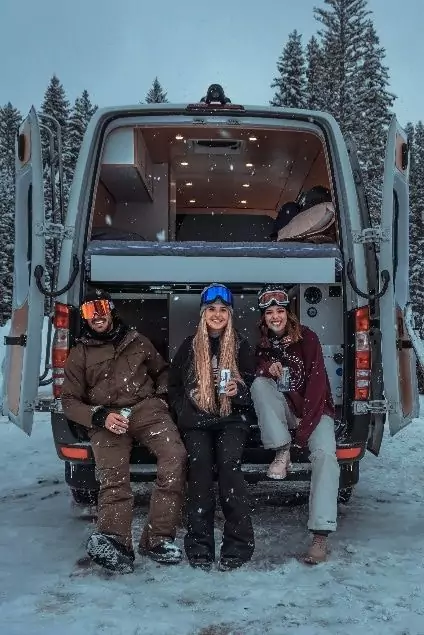
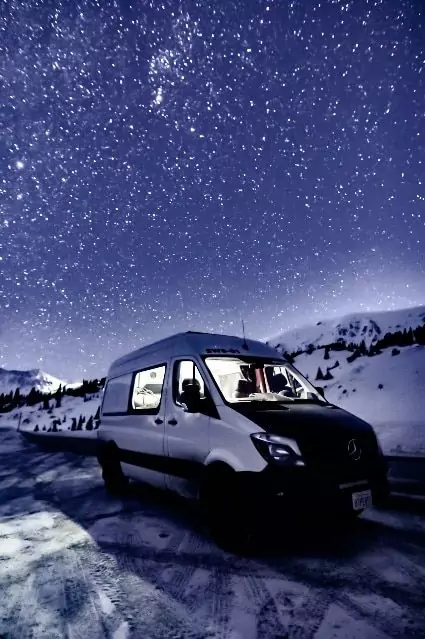
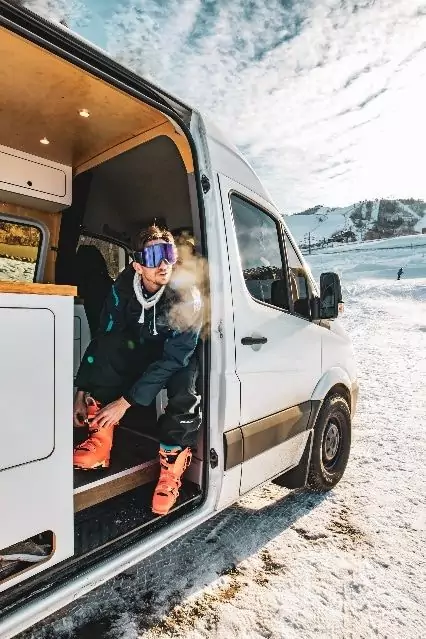
If you’ve made it all the way to the end of this blog and still aren’t convinced that vanlife is better in winter, than you are probably more interested in experiencing the year-round endless summer vibes a coastal California road trip can offer. There is nothing wrong with that! Also,nmake sure to check out our more comprehensive VanLife 101 guide for even more tips and tricks on how to make the most of your next road trip. Vanlife definitely isn’t for everyone, especially winter vanlife, but if you are looking for an adventure that will make memories to last a lifetime, we highly advise you to take the leap and rent a campervan.
